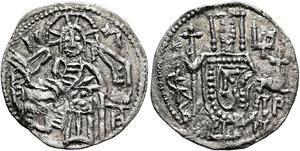The Medieval Bulgarian grosso (gros, gross) was a small circulating silver coin struck in the Second Bulgarian Kingdom in the 14th century. In modern Bulgarian language it is spelled грош (grosh or grosch), plural грошове (groshove). The name was originally introduced in 13th-century France as [denarius] grossus, literally "a thick penny", whence Old French gros, Italian grosso, Middle High German gros(se), Low German and Dutch grōte and English groat. In the 14th century, it appeared as Old Czech groš, whence Modern German Groschen.
No contemporary Bulgarian documents have survived, so it is not actually sure if the coins were thus called at the time. In style, the coins were imitative of the contemporary Venetian or other Western European coinage. They circulated until the end of the 14th century, at which time the country was conquered by the Ottomans and independent coinage ceased.
BULGARIA. Second Empire. Ivan Aleksandar, 1331–1371. Gros (Silver, 21 mm, 1.26 g, 5 h). Christ, nimbate, seated facing on throne, raising his right hand in benediction and holding book of Gospels in his left. Rev. Ivan Aleksandar standing facing, holding cruciform staff in his right hand and globus cruciger in his left hand; to left and right, ligatures. Raduchev & Zhekov 1.13.1. Somewhat rough and double struck, otherwise, about extremely fine. |




 Search for Bulgaria, Second Kingdom of: Grosso 1331 - 1371 on eBay
Search for Bulgaria, Second Kingdom of: Grosso 1331 - 1371 on eBay 